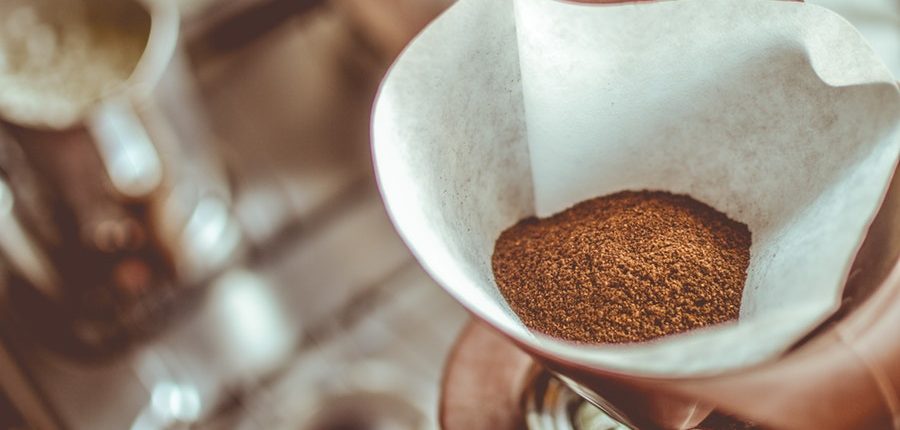Grind size – just like the roasting process – greatly affects the taste of your coffee. Using the same type of coffee, you can prepare different coffee specialities – merely by grinding coffee beans more coarsely or finely. For this reason, choosing the right grinding degree is quite important for maximizing your taste experience. Especially when it comes to cold brew coffee specialties and cold drip grind size.
Content
- Definition and Terminology
- Different Coffee Grind Sizes
- Fine Grind
- Medium Grind
- Coarse Grind
- Over Extraction
- Under Extraction
- The Perfect Coffee Grinding Degree
- Cold Drip and Cold Brew Grind Size
- Freshness
Definition and Terminology
Grind size (italian la macinatura) is composed of two components: First, the verb ” to grind”. According to the Merriam-Webster dictionary it means “to reduce to powder or small fragments by friction (as in a mill)”. Secondly, the term contains the word “size” which describes the physical dimensions or extent.
Thus, the term “grind size” describes the extent to which an object is reduced. (In our case we are obviously talking about toasted coffee beans.) In other words, it refers to the coarseness or fineness of your coffee powder. Consequently, the grinding degree measures the grain size with which a coffee mill will grind your coffee beans. Synonyms are “grind” and “grinding degree”.
The intended use of the coffee powder differs depending on the grind size. For this reason, it is arguably one of the most important factors when preparing a delicious cup of coffee.
Different Coffee Grind Sizes
With any good coffee grinder, you can set the grind size to different levels. Usually, the grinding degree for coffee beans ranges from 10 (very coarse) to 1 (very fine). However, some coffee grinders also have varying grind sizes and graduations: either 9, 12 or even 40 different grinds are available. Particularly industrial coffee grinders differ in this respect from grinders for private use.
Ultimately, it is the result that matters: If you chose a very fine grind, your coffee will have more surface area. If you grind the coffee beans at a medium grinding degree, the water will already have less surface area. If, on the other hand, you decide to grind your coffee very coarsely, the powder has a relatively small surface area.
Why is that important? When you brew coffee, it comes into contact with water. The more surface area the coffee powder offers – meaning the finer the coffee powder is ground – the faster its aromas are released.

Accordingly, the ideal cold drip grind size is particularly important. After all, when making this coffee specialty using a cold dripper, the coffee powder remains in contact with water for hours. It is therefore necessary to dissolve the aroma substances slowly. For this reason, coffee powder that is ground very coarsely is ideal for preparing cold drip coffee.
Fine Grind (Setting 1-3)
When using a finely ground coffee you only expose the coffee powder to the (usually hot) water for a very short time. This often happens by machine and under high pressure.
- Setting 1: Mocha (in this case we intentionally over extract)
- Setting 2-3: Espresso or portafilter machine
- Setting 2-4: automatic coffee maker
Medium Grind (Setting 4-6)
If the contact time of water and coffee powder of medium lenght, the grind size should be medium as well. This applies to any kind of pour over coffee as well as standart coffee machines and some other methods.
- Setting 3-5: AeroPress coffee maker
- Setting 4-6: Moka pot
- Setting 4-6: Classic filter coffee machine
- Setting 4-6: pour over coffee specialities like Kalita Wave or classical filter coffee
Coarse Grind (Setting 7-10)
Coarsely ground coffee is particularly well suited for brewing methods where the coffee powder remains in contact with water for an extended period of time. This applies to any form of full immersion as well as cold brew coffee.
- Setting 6-7: Vacuum coffee maker
- Setting 7-8: French Press coffee maker
- Setting 9-10: Bayreuth or Karlsbad coffee makers
- Setting 10: Cold Drip Coffee, Cold Brew Coffee
Over Extraction
If too many aromas (more than 22 percent to be precise) are released from the coffee powder as a result of brewing, this results in a so-called over extraction. This means that many bitter substances in particular are released from the coffee powder. Accordingly, over-extracted coffee often tastes very bitter.
Over-extraction occurs either when the grinding degree is too fine or the extraction time is too long. For example, any type of Cold Brew Coffee would be predestined for over-extraction if you mixed it with finely ground coffee powder. This is because with this method, the coffee powder is exposed to water for a long time. Some cold brew varieties are even immersed in water for hours. Therefore, a coarse cold drip grind size is best for preparing cold brewed coffee.
Under Extraction
However, the opposite can occur as well: if too few aromas are extracted from the coffee powder during the brewing process (less than 18 percent), it is called under extraction. Under extracted coffee tastes bland, thin and aqueous. Often it is even described as acidic. Is the result of too coarsely ground coffee beans combined with a too short extraction time.
Certain under extraction will happen when, for example, you combine coarsely ground coffee with a portafilter machine. As the machine works quickly and at high pressure, the extraction time is really short. However, finely ground coffee powder is the ideal choice for using with a portafilter machine. Because the finer the grind size, the faster the coffee powder releases its flavors. This means that you can also enjoy your espresso with a lovely crema.
The Perfect Coffee Grinding Degree
Selecting a grind size is closely related to how many aromatic substances you want to extract from the coffee. With over 1000 flavors, coffee has the greatest variety of aromas of all beverages. On the other hand, not all of these aromas can and should be dissolved. Certainly not all at the same time.
The Specialty Coffee Association (SCA) has long been making a rule of thumb for this: About 18 to 22 percent of the aromas are ideally released in coffee. Where possible, these should only be the desired aromas. Since we already know that we want to avoid both over extraction and under extraction, the question arises: What is the perfect coffee grind? And what is the optimal cold drip grind size?
You can use the following rule of thumb:
The finer your coffee powder, the shorter you should brew it. The coarser your ground coffee, the longer the contact time.
As with any rule, there are of course always exceptions to it. Nonetheless, in our opinion, it is a good point of reference.
Cold Brew and Cold Drip Grind Size
A coarse cold drip grind size is ideal for making cold drip coffee. Therefore, we recommend a grinding level of 9-10 out of 10 for any cold brew method. With cold brew coffee specialties, especially full immersion coffee, the coffee powder is immersed in water for hours. Thereby, the aromas dissolve particularly thoroughly and mildly. This is ideal for coarsely ground coffee. By the way, in addition to the grind size, choosing the right coffee filter is also important.

Freshness
Freshly ground coffee is the best. And we don’t just say that. Grinding coffee fresh is always a good idea. This allows you to adjust the grinding degree to your desired coffee specialty. Besides, freshly ground coffee simply tastes great. After all, the longer ground coffee powder is stored, the more flavourings get lost through the air.
